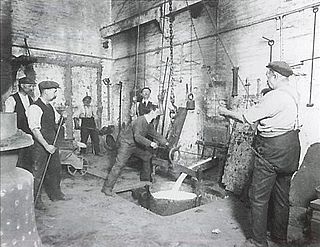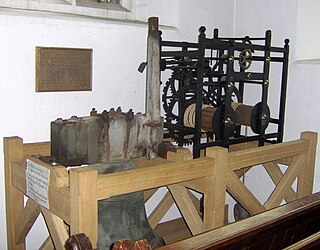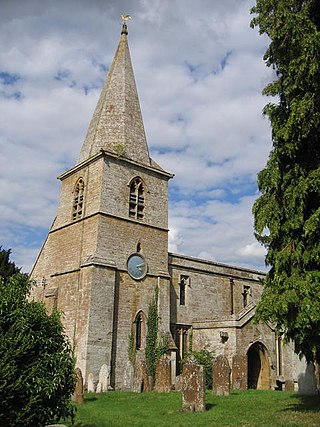
Reculver is a village and coastal resort about 3 miles (5 km) east of Herne Bay on the north coast of Kent in south-east England. It is in the ward of the same name, in the City of Canterbury district of Kent.

Badlesmere is a village and civil parish in the Swale district of Kent, England, and about five miles south of Faversham.
Broomfield is a village in the Maidstone District of Kent, England, and forms part of the civil parish of Broomfield and Kingswood. It lies 6 miles (10 km) to the east of Maidstone. The village is located just upstream of Leeds Castle on the River Len, one of the tributaries of the River Medway.

Gillett & Johnston was a clockmaker and bell foundry based in Croydon, England from 1844 until 1957. Between 1844 and 1950, over 14,000 tower clocks were made at the works. The company's most successful and prominent period of activity as a bellfounder was in the 1920s and 1930s, when it was responsible for supplying many important bells and carillons for sites across Britain and around the world.

Hoath is a semi-rural village and civil parish in the City of Canterbury local government district. The hamlets of Knaves Ash, Maypole, Ford, Old Tree, Shelvingford and Stoney Acre are included in the parish.

Charlton-on-Otmoor is a village and civil parish about 9 miles (14 km) NE of Oxford and 6 miles (10 km) SW of Bicester in Oxfordshire, England. The village, one of the seven "towns" of Otmoor, is on the northern edge of the moor on a ridge of Cornbrash. The 2011 Census recorded the parish's population as 449.

Herne is a village in South East England, divided by the Thanet Way from the seaside resort of Herne Bay. Administratively it is in the civil parish of Herne and Broomfield in Kent. Between Herne and Broomfield is the former hamlet of Hunters Forstal. Herne Common lies to the south on the A291 road.

Ulcombe is a village near the town of Maidstone in Kent, England. The name is recorded in the Domesday Book and is thought to derive from 'Owl-coomb': 'coomb' meaning 'a deep little wooded valley; a hollow in a hill side' in Old English. The original deserted Medieval village site lies to the east of the parish church in a valley. There is also a water-mill below this site, probably of early origins. It stands below the Greensand Way.

The Bilbie family were bell founders and clockmakers based initially in Chew Stoke, Somerset and later at Cullompton, Devon in south-west England from the late 17th century to the early 19th century.
Vanden Gheyn, Van den Gheyn or Van den Ghein was a family of bellfounders and carillon makers. The bell foundry was established in 1506 in Mechelen and active until the 20th century. They have been called "the most famous family of bellfounders [Belgium] has had".
Rudhall of Gloucester was a family business of bell founders in the city of Gloucester, England, who between 1684 and 1835 cast more than 5,000 bells.

Richard Phelps (c.1670–1738) was born in Avebury, Wiltshire, England. Phelps was a bellfounder, or a maker of bells, primarily for churches. He was master of the Whitechapel Bell Foundry in London from 1701 to 1738, and is best known for his large bell, Great Tom, in the steeple of St Paul's Cathedral in London, England. The foundry, in operation since at least 1570, was listed by the Guinness Book of Records as the oldest manufacturing company in Great Britain.

Swerford is a village and civil parish on the River Swere in the Cotswold Hills in Oxfordshire, England. It is about 4 miles (6.4 km) northeast of Chipping Norton. Swerford has two main neighbourhoods: Church End and East End. The area between them contains very few houses and is called Between Towns. The 2011 census recorded the parish's population as 132.
Leeds Priory, also known as Leeds Abbey, was a priory in Leeds, Kent, England, that was founded in 1119 and dissolved in 1539. A mansion was later built on the site of the priory; it was demolished in the late 18th century. The site of the former priory is a scheduled monument.
Geert van Wou was a well-known Dutch bellfounder. He is best known today for the Maria Gloriosa (1497) of Erfurt Cathedral. The son of a bellfounder, he is considered one of the most important bellfounders of the Middle Ages, though records suggest he participated in other casting.

All Saints' Church, Shuart, in the north-west of the Isle of Thanet, Kent, in the south-east of England, was established in the Anglo-Saxon period as a chapel of ease for the parish of St Mary's Church, Reculver, which was centred on the north-eastern corner of mainland Kent, adjacent to the island. The Isle of Thanet was then separated from the mainland by the sea, which formed a strait known as the Wantsum Channel. The last church on the site was demolished by the early 17th century, and there is nothing remaining above ground to show that a church once stood there.

St Mary's Church, Reculver, was founded in the 7th century as either a minster or a monastery on the site of a Roman fort at Reculver, which was then at the north-eastern extremity of Kent in south-eastern England. In 669, the site of the fort was given for this purpose by King Ecgberht of Kent to a priest named Bassa, beginning a connection with Kentish kings that led to King Eadberht II of Kent being buried there in the 760s, and the church becoming very wealthy by the beginning of the 9th century. From the early 9th century to the 11th the church was treated as essentially a piece of property, with control passing between kings of Mercia, Wessex and England and the archbishops of Canterbury. Viking attacks may have extinguished the church's religious community in the 9th century, although an early 11th-century record indicates that the church was then in the hands of a dean accompanied by monks. By the time of Domesday Book, completed in 1086, St Mary's was serving as a parish church.

The Church of St Mary the Virgin, Reculver, is an Anglican church on Reculver Lane in the village of Hillborough, in the parish of Reculver, in north-eastern Kent, England. Built between 1876 and 1878, it is the second such church on its site. The first, consecrated in 1813, was a replacement for a church of St Mary that was founded in 669 within the remains of the Roman fort at Reculver, about 1.25 miles (2 km) to the north-east, but was mostly demolished in 1809.

St Mary Magdalene Church is the Church of England parish church in the village of Ickleton in Cambridgeshire. The church is a Grade I listed building. Its parish is part of a combined benefice with those of St Peter's, Duxford and SS Mary and John, Hinxton.

John William Taylor was a philanthropist and bellfounder and a member of the John Taylor & Co dynasty of bellfounders based in Loughborough in Leicester.
















